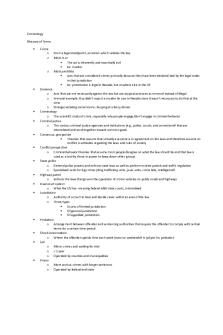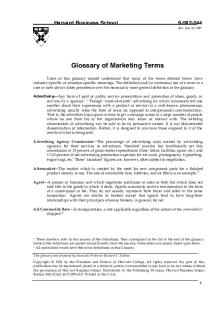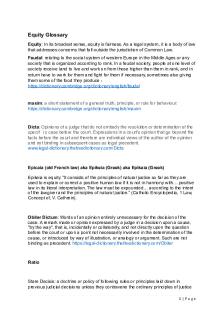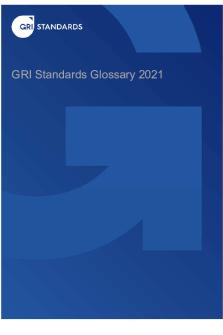GRI Standards Glossary 2021 sustainability PDF

| Title | GRI Standards Glossary 2021 sustainability |
|---|---|
| Author | Jia |
| Course | Understanding and Critiquing Sustainability |
| Institution | National University of Singapore |
| Pages | 23 |
| File Size | 757.4 KB |
| File Type | |
| Total Downloads | 101 |
| Total Views | 133 |
Summary
yep sustainability standards to measure companies sustainability reporting....
Description
GRI Standards Glossary 2021
GRI Standards Glossary 2021 The terms and definitions in the GRI Standards Glossary apply in the context of using the GRI Sustainability Reporting Standards (GRI Standards). All defined terms are underlined. If a term is not defined in the GRI Standards Glossary, or in the Glossary section of a specific GRI Standard, definitions that are commonly used and understood apply. Responsibility The GRI Standards Glossary is issued by the Global Sustainability Standards Board (GSSB). Any feedback on the GRI Standards can be submitted to [email protected] for the consideration of the GSSB. Due Process This document was developed in the public interest and in accordance with the requirements of the GSSB Due Process Protocol. It has been developed using multi-stakeholder expertise, and with regard to authoritative intergovernmental instruments and widely held expectations of organizations relating to social, environmental, and economic responsibilities. Legal liability This document, designed to promote sustainability reporting, has been developed by the Global Sustainability Standards Board (GSSB) through a unique multi-stakeholder consultative process involving representatives from organizations and report information users from around the world. While the GRI Board of Directors and GSSB encourage the use of the GRI Sustainability Reporting Standards (GRI Standards) and related Interpretations by all organizations, the preparation and publication of reports based fully or partially on the GRI Standards and related Interpretations are the full responsibility of those producing them. Neither the GRI Board of Directors, GSSB, nor Stichting Global Reporting Initiative (GRI) can assume responsibility for any consequences or damages resulting directly or indirectly from the use of the GRI Standards and related Interpretations in the preparation of reports, or the use of reports based on the GRI Standards and related Interpretations. Copyright and trademark notice This document is copyright-protected by Stichting Global Reporting Initiative (GRI). The reproduction and distribution of this document for information and/or use in preparing a sustainability report is permitted without prior permission from GRI. However, neither this document nor any extract from it may be reproduced, stored, translated, or transferred in any form or by any means (electronic, mechanical, photocopied, recorded, or otherwise) for any other purpose without prior written permission from GRI. Global Reporting Initiative, GRI and logo, GSSB and logo, and GRI Sustainability Reporting Standards (GRI Standards) and logo are trademarks of Stichting Global Reporting Initiative. © 2021 GRI. All rights reserved.
Glossary A
annual total compensation compensation provided over the course of a year Note:
Annual total compensation can include compensation such as salary, bonus, stock awards, option awards, non-equity incentive plan compensation, change in pension value and nonqualified deferred compensation earnings, and all other compensation.
anti-competitive behavior action of the organization or employees that can result in collusion with potential competitors, with the purpose of limiting the effects of market competition Examples: allocating customers, suppliers, geographic areas, and product lines; coordinating bids; creating market or output restrictions; fixing prices; imposing geographic quotas anti-trust and monopoly practice action of the organization that can result in collusion to erect barriers for entry to the sector, or another collusive action that prevents competition Examples: abuse of market position, anti-competitive mergers, cartels, price-fixing, unfair business practices area of high biodiversity value area not subject to legal protection, but recognized for important biodiversity features by a number of governmental and non-governmental organizations Note 1:
Areas of high biodiversity value include habitats that are a priority for conservation, which are often defined in National Biodiversity Strategies and Action Plans prepared under the United Nations (UN) Convention, ‘Convention on Biological Diversity’, 1992.
Note 2:
Several international conservation organizations have identified particular areas of high biodiversity value.
area protected area that is protected from any harm during operational activities, and where the environment remains in its original state with a healthy and functioning ecosystem area restored area that was used during or affected by operational activities, and where remediation measures have either restored the environment to its original state, or to a state where it has a healthy and functioning ecosystem
B
base year historical datum (such as year) against which a measurement is tracked over time baseline starting point used for comparisons Note:
In the context of energy and emissions reporting, the baseline is the projected energy consumption or emissions in the absence of any reduction activity.
basic salary fixed, minimum amount paid to an employee for performing his or her duties Note:
Basic salary excludes any additional remuneration, such as payments for overtime working or bonuses.
benefit direct benefit provided in the form of financial contributions, care paid for by the organization, or the reimbursement of expenses borne by the employee Note:
Redundancy payments over and above legal minimums, lay-off pay, extra employment injury benefit, survivors’ benefits, and extra paid holiday entitlements can also be included as a benefit.
biogenic carbon dioxide (CO2) emission emission of CO2 from the combustion or biodegradation of biomass breach of customer privacy non-compliance with existing legal regulations and (voluntary) standards regarding the protection of customer privacy business partner entity with which the organization has some form of direct and formal engagement for the purpose of meeting its business objectives Source:
Shift and Mazars LLP, UN Guiding Principles Reporting Framework, 2015; modified
Examples: affiliates, business-to-business customers, clients, first-tier suppliers, franchisees, joint venture partners, investee companies in which the organization has a shareholding position Note:
Business partners do not include subsidiaries and affiliates that the organization controls.
business relationships relationships that the organization has with business partners, with entities in its value chain including those beyond the first tier, and with any other entities directly linked to its operations, products, or services
C
Source:
United Nations (UN), Guiding Principles on Business and Human Rights: Implementing the United Nations “Protect, Respect and Remedy” Framework, 2011; modified
Note:
Examples of other entities directly linked to the organization’s operations, products, or services are a non-governmental organization with which the organization delivers support to a local community or state security forces that protect the organization’s facilities.
carbon dioxide (CO2) equivalent measure used to compare the emissions from various types of greenhouse gas (GHG) based on their global warming potential (GWP) Note:
The CO2 equivalent for a gas is determined by multiplying the metric tons of the gas by the associated GWP.
catchment area of land from which all surface runoff and subsurface water flows through a sequence of streams, rivers, aquifers, and lakes into the sea or another outlet at a single river mouth, estuary, or delta Source:
Alliance for Water Stewardship (AWS), AWS International Water Stewardship Standard, Version 1.0, 2014; modified
Note:
Catchments include associated groundwater areas and might include portions of waterbodies (such as lakes or rivers). In different parts of the world, catchments are also referred to as ‘watersheds’ or ‘basins’ (or sub-basins).
CFC11 (trichlorofluoromethane) equivalent measure used to compare various substances based on their relative ozone depletion potential (ODP) Note:
The reference level of 1 is the potential of CFC-11 (trichlorofluoromethane) and CFC-12 (dichlorodifluoromethane) to cause ozone depletion.
child person under the age of 15 years, or under the age of completion of compulsory schooling, whichever is higher Note 1:
Exceptions can occur in certain countries where economies and educational facilities are insufficiently developed, and a minimum age of 14 years applies. These countries of exception are specified by the International Labour Organization (ILO) in response to a special application by the country concerned and in consultation with representative organizations of employers and workers.
Note 2:
The ILO Minimum Age Convention, 1973, (No. 138), refers to both child labor and young workers.
circularity measures measures taken to retain the value of products, materials, and resources and redirect them back to use for as long as possible with the lowest carbon and resource footprint possible, such that fewer raw materials and resources are extracted and waste generation is prevented close call work-related incident where no injury or ill health occurs, but which has the potential to cause these Source:
International Organization for Standardization. ISO 45001:2018. Occupational health and safety management systems — Requirements with guidance for use. Geneva: ISO, 2018; modified
Note:
A ‘close call’ might also be referred to as a ‘near-miss’ or ‘near-hit’.
collective action to combat corruption voluntary engagement with initiatives and stakeholders to improve the broader operating environment and culture, in order to combat corruption Examples: proactive collaboration with civil society organizations, governments and the wider public sector, peers, trade unions collective bargaining all negotiations that take place between one or more employers or employers' organizations, on the one hand, and one or more workers' organizations (e.g., trade unions), on the other, for determining working conditions and terms of employment or for regulating relations between employers and workers Source:
International Labour Organization (ILO), Collective Bargaining Convention, 1981 (No. 154); modified
community development program plan that details actions to minimize, mitigate, or compensate for adverse social and/or economic impacts, and/or to identify opportunities or actions to enhance positive impacts of a project on the community commuting incident incident that occurs when the worker is traveling between a place of private activity (e.g., residence, restaurant) and a place of work or workplace Note:
Modes of travel include motor vehicles (e.g., motorcycles, cars, trucks, buses), railed vehicles (e.g., trains, trams), bicycles, aircrafts, and walking, among others.
confirmed incident of corruption incident of corruption that has been found to be substantiated Note:
Confirmed incidents of corruption do not include incidents of corruption that are still under investigation in the reporting period.
conflict of interest situation where an individual is confronted with choosing between the requirements of their function in the organization and their other personal or professional interests or responsibilities
conservation and efficiency initiative organizational or technological modification that allows a defined process or task to be carried out using less energy Examples: conversion and retrofitting of equipment such as energy-efficient lighting, elimination of unnecessary energy use due to changes in behavior, process redesign continued employability adaptation to the changing demands of the workplace through the acquisition of new skills corruption ‘abuse of entrusted power for private gain’, which can be instigated by individuals or organizations Source:
Transparency International, Business Principles for Countering Bribery, 2011
Note:
Corruption includes practices such as bribery, facilitation payments, fraud, extortion, collusion, and money laundering. It also includes an offer or receipt of any gift, loan, fee, reward, or other advantage to or from any person as an inducement to do something that is dishonest, illegal, or a breach of trust in the conduct of the enterprise’s business. This can include cash or in-kind benefits, such as free goods, gifts, and holidays, or special personal services provided for the purpose of an improper advantage, or that can result in moral pressure to receive such an advantage.
customer privacy right of the customer to privacy and personal refuge Examples: the obligation to observe confidentiality; the protection of data; the protection of information or data from misuse or theft; the use of information or data for their original intended purpose only, unless specifically agreed otherwise Note:
D
Customers are understood to include end-customers (consumers) as well as business-to-business customers.
defined benefit plan post-employment benefit plan other than a defined contribution plan defined contribution plan post-employment benefit plan under which an entity pays fixed contributions into a separate entity (a fund) and will have no legal or constructive obligation to pay further contributions if the fund does not hold sufficient assets to pay all employee benefits relating to employee service in the current and prior periods direct (Scope 1) GHG emissions greenhouse gas (GHG) emissions from sources that are owned or controlled by the organization Example:
CO2 emissions from fuel consumption
Note:
A GHG source is any physical unit or process that releases GHG into the atmosphere.
discrimination act and result of treating persons unequally by imposing unequal burdens or denying benefits instead of treating each person fairly on the basis of individual merit Note:
Discrimination can also include harassment, defined as a course of comments or actions that are unwelcome, or should reasonably be known to be unwelcome, to the person towards whom they are addressed.
disposal any operation which is not recovery, even where the operation has as a secondary consequence the recovery of energy Source:
European Union (EU), Waste Framework Directive, 2008 (Directive 2008/98/EC)
Note:
Disposal is the end-of-life management of discarded products, materials, and resources in a sink or through a chemical or thermal transformation that makes these products, materials, and resources unavailable for further use.
due diligence process to identify, prevent, mitigate, and account for how the organization addresses its actual and potential negative impacts
E
Source:
Organisation for Economic Co-operation and Development (OECD), OECD Guidelines for Multinational Enterprises, 2011; modified United Nations (UN), Guiding Principles on Business and Human Rights: Implementing the United Nations “Protect, Respect and Remedy” Framework, 2011; modified
Note:
See section 2.3 in GRI 1: Foundation 2021 for more information on ‘due diligence’.
effluent treated or untreated wastewater that is discharged Source:
Alliance for Water Stewardship (AWS), AWS International Water Stewardship Standard, Version 1.0, 2014
employee individual who is in an employment relationship with the organization according to national law or practice employee category breakdown of employees by level (such as senior management, middle management) and function (such as technical, administrative, production) Note:
This information is derived from the organization’s own human resources system.
employee turnover employees who leave the organization voluntarily or due to dismissal, retirement, or death in service energy indirect (Scope 2) GHG emissions greenhouse gas (GHG) emissions that result from the generation of purchased or acquired electricity, heating, cooling, and steam consumed by the organization energy reduction amount of energy no longer used or needed to carry out the same processes or tasks Note:
Energy reduction does not include overall reduction in energy consumption from reducing production capacity or outsourcing organizational activities.
entry level wage full-time wage in the lowest employment category Note:
Intern or apprentice wages are not considered entry level wages.
environmental laws and regulations laws and regulations related to all types of environmental issues applicable to the organization Note 1:
Environmental issues can include those such as emissions, effluents, and waste, as well as material use, energy, water, and biodiversity.
Note 2:
Environmental laws and regulations can include binding voluntary agreements that are made with regulatory authorities and developed as a substitute for implementing a new regulation.
Note 3:
Voluntary agreements can be applicable if the organization directly joins the agreement, or if public agencies make the agreement applicable to organizations in their territory through legislation or regulation.
environmental protection expenditure expenditure on environmental protection by the organization, or on its behalf, to prevent, reduce, control, and document environmental aspects, impacts, and hazards Examples: expenditures on clean-up, disposal, sanitation, treatment exposure quantity of time spent at or the nature of contact with certain environments that possess various degrees and kinds of hazard, or proximity to a condition that might cause injury or ill health (e.g., chemicals, radiation, high pressure, noise, fire, explosives)
F
financial assistance direct or indirect financial benefits that do not represent a transaction of goods and services, but which are an incentive or compensation for actions taken, the cost of an asset, or expenses incurred Note:
The provider of financial assistance does not expect a direct financial return from the assistance offered.
forced or compulsory labor all work and service that is exacted from any person under the menace of any penalty and for which the said person has not offered herself or himself voluntarily Source:
International Labour Organization (ILO), Forced Labour Convention, 1930 (No. 29); modified
Note 1:
The most extreme examples of forced or compulsory labor are slave labor and bonded labor, but debts can also be used as a means of maintaining workers in a state of forced labor.
Note 2:
Indicators of forced labor include withholding identity papers, requiring compulsory deposits, and compelling workers, under threat of firing, to work extra hours to which they have not previously agreed.
formal agreement written document signed by all relevant parties declaring a mutual intention to abide by what is stipulated in the document Examples: a local collective bargaining agreement, a national or international framework agreement formal joint management-worker health and safety committee committee composed of management and worker representatives, whose function is integrated into an organizational structure, and which operates according to agreed written policies, procedures, and rules, and helps facilitate worker participation and consultation on matters of occupational health and safety freedom of association right of employers and workers to form, to join and to run their own organizations without prior authorization or interference ...
Similar Free PDFs

Glossary
- 2 Pages

Glossary
- 2 Pages

PEAK GRI Flavier Nov2018
- 54 Pages

GRI G4 Versi Indonesia
- 94 Pages

Gri 301 materials 2016 - Readings.
- 11 Pages

Corporate Sustainability
- 10 Pages

Criminology glossary
- 5 Pages

Psychology glossary
- 64 Pages

ATS1310 Glossary
- 1 Pages

MKT Glossary
- 24 Pages

Glossary Equity
- 2 Pages

Air France KLM GRI-table 2016 1
- 7 Pages

Simapro Sustainability Assignment
- 16 Pages

Sustainability - Paulina Garza
- 3 Pages
Popular Institutions
- Tinajero National High School - Annex
- Politeknik Caltex Riau
- Yokohama City University
- SGT University
- University of Al-Qadisiyah
- Divine Word College of Vigan
- Techniek College Rotterdam
- Universidade de Santiago
- Universiti Teknologi MARA Cawangan Johor Kampus Pasir Gudang
- Poltekkes Kemenkes Yogyakarta
- Baguio City National High School
- Colegio san marcos
- preparatoria uno
- Centro de Bachillerato Tecnológico Industrial y de Servicios No. 107
- Dalian Maritime University
- Quang Trung Secondary School
- Colegio Tecnológico en Informática
- Corporación Regional de Educación Superior
- Grupo CEDVA
- Dar Al Uloom University
- Centro de Estudios Preuniversitarios de la Universidad Nacional de Ingeniería
- 上智大学
- Aakash International School, Nuna Majara
- San Felipe Neri Catholic School
- Kang Chiao International School - New Taipei City
- Misamis Occidental National High School
- Institución Educativa Escuela Normal Juan Ladrilleros
- Kolehiyo ng Pantukan
- Batanes State College
- Instituto Continental
- Sekolah Menengah Kejuruan Kesehatan Kaltara (Tarakan)
- Colegio de La Inmaculada Concepcion - Cebu

